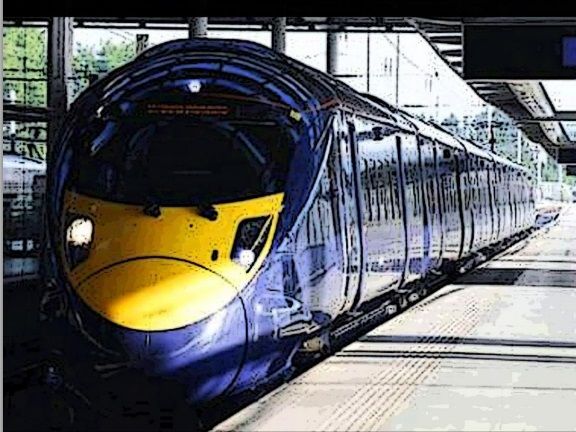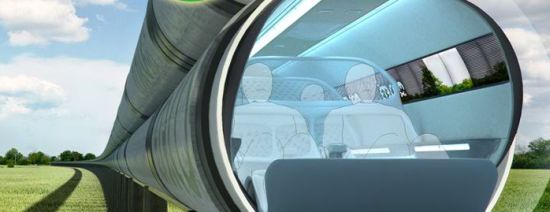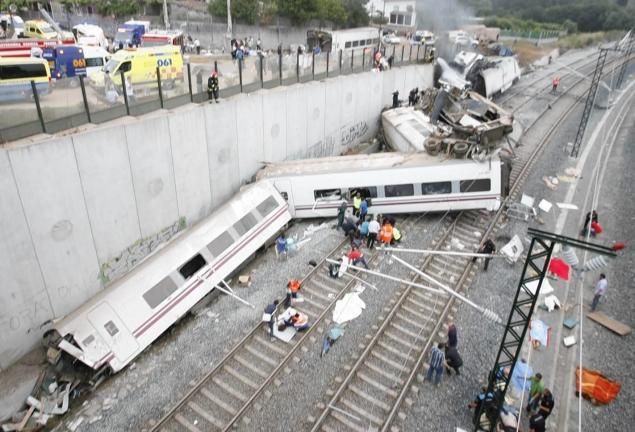Author's posts
Sep 16 2013
Sunday Train: Rapid Rail and Pedal to the Metal Climate Change Policy (part 1)
 Earlier this month, Micheal Hoexter offered a “A Pedal-to-the-Metal Plan” to respond to the challenge of Climate Chaos at New Economic Perspectives, also crossposted to Naked Capitalism (part 1, part 2 and part 3).
Earlier this month, Micheal Hoexter offered a “A Pedal-to-the-Metal Plan” to respond to the challenge of Climate Chaos at New Economic Perspectives, also crossposted to Naked Capitalism (part 1, part 2 and part 3).
His plan is an overarching plan for a 15-20 year equivalent-to-worldwar mobilization of our economy for the purpose of reducing the degree of severity of the climate catastrophe that our economy has signed up for under status quo policies. What I am looking at this week is the role that Rapid Freight Rail and Rapid Passenger Rail can play as part of the mix of Pedal to the Metal Climate Change policies addressing transport.
There is a tremendous gap today between the maximum that is politically feasible and the minimum required to make a serious dent in the challenge that we face. This piece lies primarily on the “minimum necessary” side of our current political dysfunction, looking at necessary (though not sufficient) structural transformations of our transportation system. However, it is also address in part to the “maximum feasible” side, since these are policies that can be put into place on the back of only a partial political breakthrough, which may not on its own be enough to get a complete Pedal to the Metal policy package in place.
I argue that both Rapid Freight Rail and Rapid Passenger Rail can play the roles of “front-runner” policies on the transport side of a Pedal to the Metal Climate Change policy package. One of the things we look for in prospective front-runner policies is that the policies stand on their own, but they also strongly complement follow-up policies that we would look to put into place to complete the Pedal to the Metal policy package.
Sep 02 2013
Sunday Train: The Proposed Chicago – Fort Wayne – Columbus Rapid Rail Service
cross-posted from Voices on the Square
 The Northeast Indiana Passenger Rail Association, on 28 June 2013, announced the results of their study of a Northern Indiana / Ohio rail corridor to Chicago:
The Northeast Indiana Passenger Rail Association, on 28 June 2013, announced the results of their study of a Northern Indiana / Ohio rail corridor to Chicago:
The proposed system would operate twelve trains each way per day, including at least six express schedules. With modern diesel equipment running at speeds of up to 110 miles per hour to start, the three-hundred mile trip between downtown Chicago and downtown Columbus would normally require only three hours, forty-five minutes (express service), or four hours (local service). Track and safety improvements in a potential future phase would support speeds up to 130 mph and a downtown Chicago to downtown Columbus express time of three hours, twenty minutes.
Longer time readers of the Sunday Train may recognize this as a piece of the Ohio Hub project, first developed in the 1990’s. At the time that the Ohio Hub was originally developed, the Fort Wayne to Chicago link was slated to be the second connection from Ohio to Chicago, with the envisioned phasing being:
- Phase 1: Chicago to Detroit; and Cincinnati – Columbus – Cleveland ~ the Triple C backbone of the Ohio Hub
- Phase 2: Cleveland to Toledo, Toledo to Detroit, completing Cleveland to Chicago via Michigan
- Phase 3: Fort Wayne to Chicago; Toledo to Fort Wayne; Columbus to Fort Wayne; Cincinnati – Indianapolis – Gary – Chicago, completing Dayton/Cincinnati to Chicago via Indianapolis and Columbus/Cleveland to Chicago via Fort Wayne
- Phase 4: Cleveland to Pittsburgh via Youngstown, connecting with services to Philadelphia / New York on the Keystone Corridor
- Phase 5: Columbus to Pittsburgh, connecting with services to Philadelphia / New York on the Keystone Corridor
- Phase 6: Cleveland to Toronto via Buffalo and Niagara Falls, connecting with services to New York and Boston on the Empire Corridor
So what the Northeast Indiana Passenger Rail Association is doing is pulling out a section of the Phase Three of the Ohio Hub and proposing it as a free-standing project. This free-standing project would bring intercity rail service back to Columbus, the largest or second largest urban area lacking rail service (depending on how you count Phoenix), and to Fort Wayne, the largest urban area in Indiana without intercity passenger rail service.
Aug 26 2013
Sunday Train: Florida Rapid Rail project moves toward a 2015 ribbon cutting
cross-posted from Voices on the Square
 I saw on the twitter feeds of some transit/transport bloggers (twitter list) some interesting news about the ongoing All Aboard Florida project for a 3hr rail service between Miami and Orlando. They are seeking land for their Miami station complex:
I saw on the twitter feeds of some transit/transport bloggers (twitter list) some interesting news about the ongoing All Aboard Florida project for a 3hr rail service between Miami and Orlando. They are seeking land for their Miami station complex:
Managers for All Aboard Florida, the project to build an Orlando-to-Miami passenger train service, are about to begin negotiations with Miami’s Community Redevelopment Agency to acquire two parcels in downtown Miami as part of the plan to build a massive train station and transportation hub downtown.
…
He [Michael Reininger, president and chief development officer for the train project] said the two parcels are key to the project, as they are integral to the planned station and transport hub, a project he said will dramatically transform downtown Miami and Overtown, where project managers expect to create jobs and new opportunities for area residents and businesses. “We are not just developing these two blocks,” Reininger said. “In fact, we’re developing a very major infrastructure and development program that will be transformative for the entirety of downtown Miami.”Besides building the Miami station for the Miami-Orlando train, Reininger said, All Aboard Florida is also planning a transportation hub that would provide links between the intercity train and the Miami-Dade transit services there such as Metrorail, Metromover and Metrobus.
And are also bidding for additional develoment on a neighboring site, which would crosslink the All Aboard Florida Station to the MDM proposals for a new Marriot at Miami Worldcenter:
The company that is planning to build a 3-hour rail link between Miami and Orlando recently responded to an RFP by the Overtown CRA for a plot of land near a station that they are planning to build in downtown Miami.
All Aboard Florida proposes to build office, retail and residential uses, including a 24-story tower on the overtown parcels. It would be linked to a new Marriott at Miami Worldcenter proposed by MDM, as well as the All Aboard Florida station.
Aug 19 2013
Using the Hype-Loop to Understand the California HSR System
Cross-posted from its origin station at Voices on the Square
 On Monday, entrepreneur Elon Musk launched on attack on the California HSR system in the guise of a pie in the sky alternative that he has dubbed the “Hyperloop”. Now, I got into this topic from the back end, since I waited for the technical people to download the PDF and chew into it before giving it a serious look, so when I first encountered the notion floated that this is just a car builder (well, an electric car builder) attacking a rival form of transport, I thought that might involve some shaky inference regarding motive for otherwise puzzling statements …
On Monday, entrepreneur Elon Musk launched on attack on the California HSR system in the guise of a pie in the sky alternative that he has dubbed the “Hyperloop”. Now, I got into this topic from the back end, since I waited for the technical people to download the PDF and chew into it before giving it a serious look, so when I first encountered the notion floated that this is just a car builder (well, an electric car builder) attacking a rival form of transport, I thought that might involve some shaky inference regarding motive for otherwise puzzling statements …
… but then I read the first paragraph of the blog post where he introduced the proposal, and there really isn’t any doubt:
When the California “high speed” rail was approved, I was quite disappointed, as I know many others were too. How could it be that the home of Silicon Valley and JPL – doing incredible things like indexing all the world’s knowledge and putting rovers on Mars – would build a bullet train that is both one of the most expensive per mile and one of the slowest in the world? Note, I am hedging my statement slightly by saying “one of”. The head of the California high speed rail project called me to complain that it wasn’t the very slowest bullet train nor the very most expensive per mile.
So this is explicitly a proposal from the guy who made big bucks on an internet payment system, Paypal, showing how the California HSR is old, outdated technology and if he wasn’t busy doing other things, why, he could give us an intercity transport system that would knock our socks off.
Aug 12 2013
Sunday Train: The Myth of Baseload Power
cross-posted from the Sunday Train origin station Voices on the Square
 In Baseload power is a myth: even intermittent renewables will work, Mark Diesendorf, Asst. Professor and Deputy Director of the Institute of Environmental Studies at the University of New South Wales (Australia), writes:
In Baseload power is a myth: even intermittent renewables will work, Mark Diesendorf, Asst. Professor and Deputy Director of the Institute of Environmental Studies at the University of New South Wales (Australia), writes:
The old myth was based on the incorrect assumption that base-load demand can only be supplied by base-load power stations; for example, coal in Australia and nuclear in France. However, the mix of renewable energy technologies in our computer model, which has no base-load power stations, easily supplies base-load demand. Our optimal mix comprises wind 50-60%; solar PV 15-20%; concentrated solar thermal with 15 hours of thermal storage 15-20%; and the small remainder supplied by existing hydro and gas turbines burning renewable gases or liquids. (Contrary to some claims, concentrated solar with thermal storage does not behave as base-load in winter; however, that doesn’t matter.)
Anyone who engages in online discussion on issues involving renewable energy for any length of time will encounter the myth that renewable energy is unreliable in supplying base-load demand. This myth is pushed into the discussion with substantial financial investment, directly and indirectly, by vested interests in continued reliance on the Global Suicide Pact power sources of coal, petroleum, and natural gas. Writing from Australia, Mark Diesendorf flags the use of the Murdoch press empire in propagating this myth. Here in the United States, the myth is promoted by both Big Coal and Big Oil funded propaganda mills ~ including those libertarian “think tanks” that argue against the government getting involved in defending our economy from the prospect of collapse in the face of climate chaos …
… because the “free market”, together with billions of dollars of government subsidies for fossil fuel industry and tens or hundreds of billions of unfunded third party costs of fossil fuel consumption, will surely choose best.
Aug 05 2013
Sunday Train: The Triboro RX & the G Train to the Brooklyn Army Terminal
Cross-posted from Voices on the Square
 A transit rail corridor plan has been taken off the shelf, dusted off, and tossed into the NYC Mayoral Race, and according to Alon Levy, the circumstances are enough to disqualify Christine Quin, one of the leading candidates:
A transit rail corridor plan has been taken off the shelf, dusted off, and tossed into the NYC Mayoral Race, and according to Alon Levy, the circumstances are enough to disqualify Christine Quin, one of the leading candidates:
According to Capital New York, leading mayoral contender Christine Quinn has just made up a price tag of $25 billion for Triboro, while claiming that paving portions of the right-of-way for buses will cost only $25 million. This is on the heels of city council member Brad Lander’s proposal for more investment in bus service. The difference is that Lander proposed using buses for what buses do well, that is service along city streets, and his plan includes bus lanes on major street and what appears to be systemwide off-board fare collection. In contrast, Quinn is just channeling the “buses are always cheaper than rail” mantra and proposing to expand bus service at the expense of a future subway line.
…
But the reason Quinn is unfit for office rather than just wrong is the trust factor coming from this. She isn’t just sandbagging a project she thinks is too hard; the MTA is doing that on its own already. She appears to be brazenly making up outlandish numbers in support of a mantra about bus and rail construction costs. Nor has anyone else proposed a Triboro busway – she made the logical leap herself, despite not having any background in transit advocacy. Politicians who want to succeed need to know which advocates’ ideas to channel, and Quinn is failing at that on the transit front. If I can’t trust anything she says about transit, how can I trust anything she says about the effectiveness of stop-and-frisk, or about housing affordability, or about the consequences of labor regulations?
…
Update 2: Quinn admitted the mistake on the rail plan, and revised the estimate of the cost down to $1 billion, but sticks to the bus plan and its $25 million estimate.
Aug 03 2013
Summers: Economic Inequality a Problem, but not the Fed Chair’s Responsibility
 Well, OK, I’m summarizing. I was startled to read at Agent Orange that Summers was a progressive thinker because Summers recognizes the massive increase in economic inequality that has taken place over the past three or four decades:
Well, OK, I’m summarizing. I was startled to read at Agent Orange that Summers was a progressive thinker because Summers recognizes the massive increase in economic inequality that has taken place over the past three or four decades:
It would be, however, a serious mistake to suppose that our only problems are cyclical or amenable to macroeconomic solutions. Just as evolution from an agricultural to an industrial economy had far reaching implications for society, so too will the evolution from an industrial to a knowledge economy. Witness structural trends that predate the Great Recession and will be with us long after recovery is achieved: The most important of these is the strong shift in the market reward for a small minority of persons, relative to the rewards available to everyone else. In the United States, according to a recent CBO study, the incomes of the top 1 percent of the population have, after adjusting for inflation, risen by 275 percent from 1979 to 2007. At the same time, incomes for the middle class (in the study, the middle 60 percent of the income scale) grew by only 40 percent. Even this dismal figure overstates the fortunes of typical Americans; the number unable to find work or who have abandoned the job search has risen. In 1965, only 1 in 20 men between ages 25 and 54 was not working. By the end of this decade it will likely be 1 in 6-even if a full cyclical recovery is achieved.
…
There is no issue that will be more important to the politics of the industrialized world over the next generation than its response to a market system that distributes rewards increasingly inequitably and generates growing disaffection in the middle class. …
Jul 29 2013
Sunday Train: Traveling to Our Death and The Fatal Santiago Train Derailment
 At the time that I start writing, the death toll from the train wreck that took place in Santiago de Compostela in Spain has risen to 79. According to an account shortly after the crash (sp):
At the time that I start writing, the death toll from the train wreck that took place in Santiago de Compostela in Spain has risen to 79. According to an account shortly after the crash (sp):
Alternating AVE segments with segments of conventional track or of lower specifications occurs at other points of the line. The Alvia train between Madrid and Ferrol, the fastest going through Santigo, travels on different tracks. Between Madrid and Olmedo (Valladolid) it takes advantage of the AVE track. Then, between Olmedo and Ourense it returns to a conventional track, waiting for the completion of the AVE works already underway. Finally, between Ourense and Ferrol it again joins the AVE line, which at the entrance to Santiago goes alongside the old track.
At that moment, the train must brake and when it reaches the tight bend where the accident took place it must leave it speed at barely 80km/h. The velocity drop at that point is very steep: form 200 km/h to 80 in a short time span.
The causes of the excessive speed are still not known. The line where the accident occurred is still not within the ERTMS (European Rail Traffic Management System), a rail traffic mnagement system preventing a train from exceeding the established speed limit or disobey stop signals, very similar to the automatic alert systems already installed in many European countries. This system is the one deployed, for instance, on the Madrid-Barcelona AVE line in october 2011. (translation by Migeru at the European Tribune)
The statement “the cause of the excessive speed are still not know” is referring to the proximate cause, since the ultimate cause is stated directly after: the line is not within the version of Positive Train Control signal system used in Europe, the ERTMS.
30 July: Also see this UPDATE at Voices on the Square: The Santiago Train Derailment Could Have Been Prevented with a Euro 6,000 beacon
Jul 22 2013
Sunday Train: Net Energy Yield and the Steel Interstate Energy Revolution
crossposted from Voices on the Square
 In the online support for the April, 2013 Scientific American article on Energy Return on Investment (EROI), Scientific American online interviewed Charles Hall, developer of the EROI concept, on whether Fossil Fuels will be able to maintain economic growth. In one of his answers, Charles Hall responds to the question:
In the online support for the April, 2013 Scientific American article on Energy Return on Investment (EROI), Scientific American online interviewed Charles Hall, developer of the EROI concept, on whether Fossil Fuels will be able to maintain economic growth. In one of his answers, Charles Hall responds to the question:
What happens when the EROI gets too low? What’s achievable at different EROIs?
He says:
If you’ve got an EROI of 1.1:1, you can pump the oil out of the ground and look at it. If you’ve got 1.2:1, you can refine it and look at it. At 1.3:1, you can move it to where you want it and look at it. We looked at the minimum EROI you need to drive a truck, and you need at least 3:1 at the wellhead. Now, if you want to put anything in the truck, like grain, you need to have an EROI of 5:1. And that includes the depreciation for the truck. But if you want to include the depreciation for the truck driver and the oil worker and the farmer, then you’ve got to support the families. And then you need an EROI of 7:1. And if you want education, you need 8:1 or 9:1. And if you want health care, you need 10:1 or 11:1.
Civilization requires a substantial energy return on investment. You can’t do it on some kind of crummy fuel like corn-based ethanol [with an EROI of around 1:1].
A big problem we have facing the alternatives is they’re all so low EROI. We’d all like to go toward renewable fuels, but it’s not going to be easy at all. And it may be impossible. We may not be able to sustain our civilization on these alternative fuels. I hope we can, but we’ve got to deal with it realistically.
Jul 15 2013
Sunday Train: Why Does Congressman Mica Lie About Amtrak?
cross-posted from Voices on the Square
 Congressman John Mica, Republican from the Florida 7th district and member (former chair) of the House Committee on Transportation and Infrastructure, has been on the attack against Amtrak again. During the testimony to the committee by John Robert Smith, head of Transportation for America and Reconnecting America, and former Republican mayor of Meridian, Mississippi, faced aggressive questioning by Congressman Mica promoting his desired defunding of Amtrak:
Congressman John Mica, Republican from the Florida 7th district and member (former chair) of the House Committee on Transportation and Infrastructure, has been on the attack against Amtrak again. During the testimony to the committee by John Robert Smith, head of Transportation for America and Reconnecting America, and former Republican mayor of Meridian, Mississippi, faced aggressive questioning by Congressman Mica promoting his desired defunding of Amtrak:
… But Mica spared his real invective for the next part, where he let Smith know he’s seen “your little memo that you sent to my mayor.” Something about the belittling, eyes-in-the-back-of-my-head tone there was just chilling, like he’s saying he found the love notes Smith was writing to his wife. “House of Representatives slash Amtrak funding, putting the future of the national system in jeopardy!” Mica read the line in a high-pitched tone, mocking the hysteria Smith was clearly exhibiting when calling Winter Park Mayor Ken Bradley’s attention to the House cuts.
Does Smith really think a cut of $1.4 billion to $950 million is such a big deal? Well, yeah, actually. “Don’t you think the United States is under threat when you’re in debt up to your eyeballs, when you’re borrowing 40 cents on the dollar to underwrite your service?” Mica exploded. “You’re aware that every ticket on Amtrak last year was underwritten more than $40 per passenger ticket? You’re aware of that?”
…
Mica railed against Amtrak’s “Soviet-style operations” and the money losses on food service aboard the trains and asked Smith if he should “go back and tell that mother [of the soldier not getting hot breakfasts], ‘You know, we need to put this money into Amtrak; we can’t take any cuts out of Amtrak.'”
To which John Robert Smith firmly replied: “That’s a false choice, Congressman.”
Indeed, you don’t have to take the word of DC Streetsblog about the exchange, as it has been put up on youtube:

Recent Comments